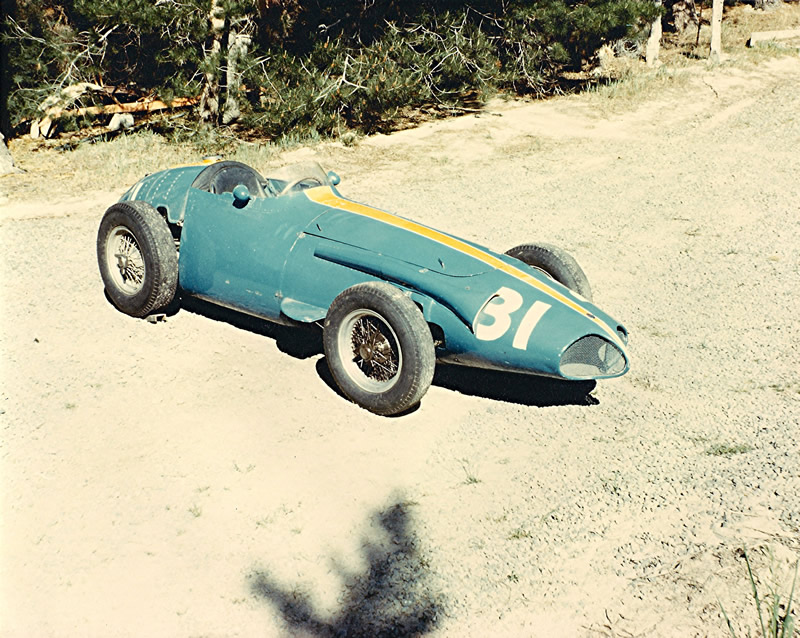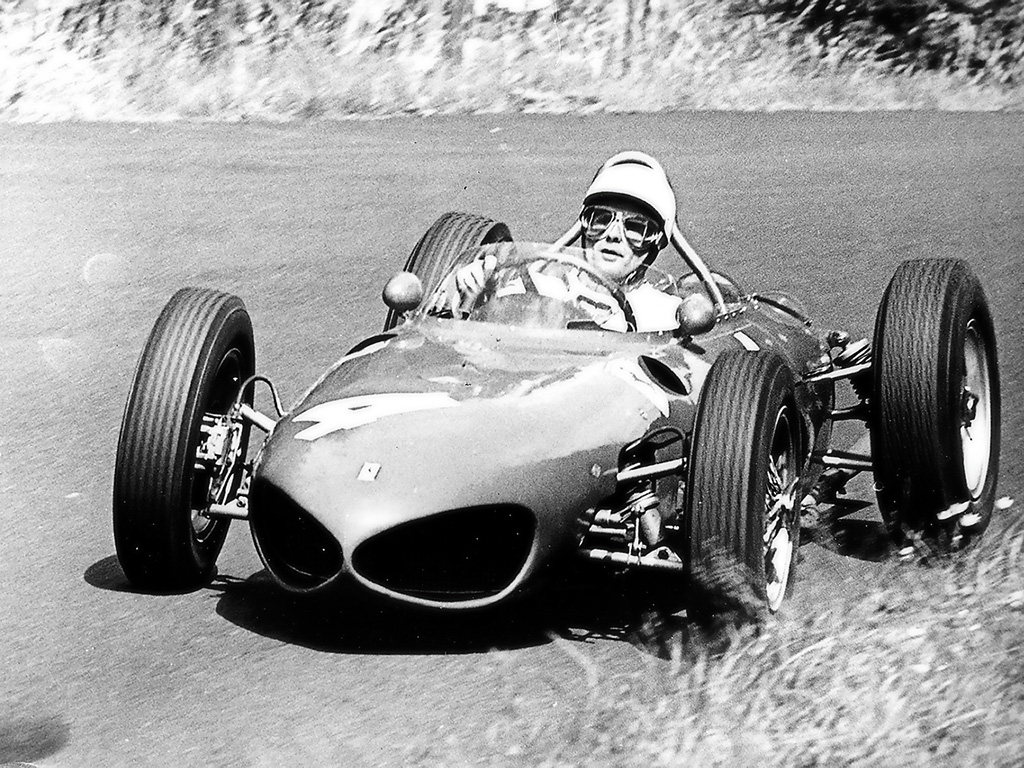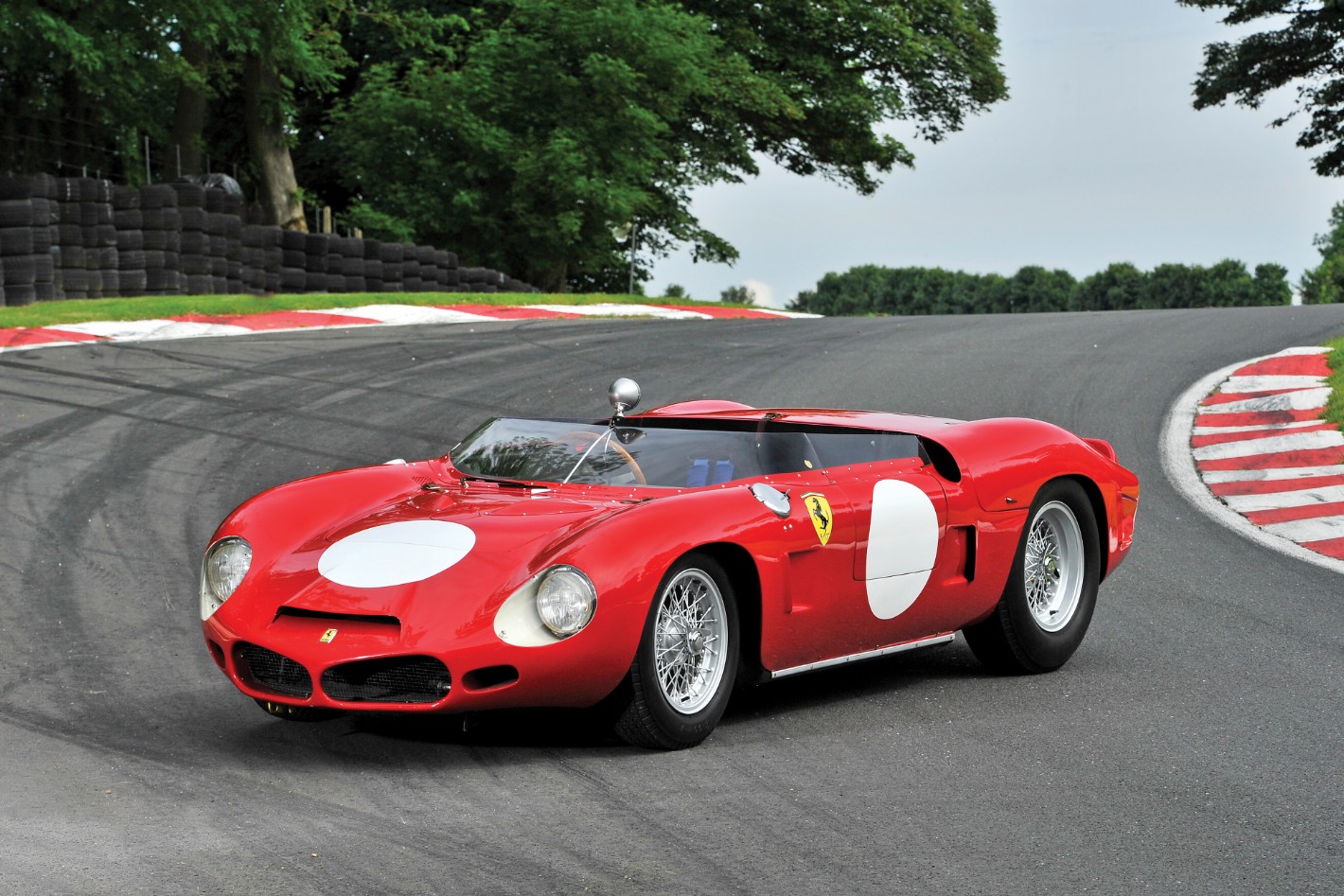Peter Giddings Racing
FANTUZZI'S NOSE AND THE MASERATI CONNECTIONIn the June 1988 Road and Track article by Phil Hill on the awesome 1961 Ferrari 250 TRI, he states that he knows of no particular explanation behind the design of the twin nostril snout. In the book Chiti Grand Prix by Piero Casucci, Carlo Chiti, who was Ferrari's Technical Manager at the time, claimed credit for the design stating that "the characteristic nostrils on the front of the 246P and the 156 F1 were a result of the research we carried out in our little wind tunnel." But for all of you readers who are dying to know the real answer to this particular piece of motoring trivia, here goes! In early 1957, leading New Zealand racer Ross Jensen (who in his day could give a certain Mr. Bruce McLaren a run for his money) decided to sell his Maserati 250F (the ex-Stirling Moss car, #2508) to fellow Kiwi Johnny Mansell. Jensen had decided to purchase instead Bruce Halford's Maserati 250F, chassis #2504 (the ex-B. Bira 1955 New Zealand Grand Prix winning car). While, by chassis number, Halford's car was even older than #2508, the astute Jensen knew that, in fact, it was much closer to current factory specifications as Halford actually kept his car at the Maserati works. In 1958, prior to importing #2504, Jensen visited the factory and arranged for a complete overhaul. Before leaving for Italy, Jensen had been convinced by one "Buzz" Perkins "not to import just any 250F Maserati." If Jensen wanted to gain lots of publicity (and more importantly sponsorship) he should instead purchase "something famous, and preferably a car with a distinctive look." With Perkins' instructions ringing loud in his ears, Jensen then visited with Fantuzzi, the famed rotund constructor of Maserati competition coachwork. Fantuzzi could not believe his luck when Jensesn asked him to modify #2504 to "look different." Fantuzzi explained that he had been playing around in his mind with a design for a twin-nostril nose. Jensen agreed this certainly sounded unique, and later on in the day was presented with a wire mock-up of the nose, some suggested changes to the carburetor air intake, and a proposed distinctive blue and yellow paint job. Jensen telephoned through his progress report to Perkins (secretary of the New Zealand Grand Prix Association, and by all accounts New Zealand's answer to P. T. Barnum), who then went to work on concocting the story that Jensen's "new" Maserati was no less than the "Scuderia Republic of El Salvador" car. Having returned to New Zealand, Jensen subsequently received his early, but now later-looking, twin-nostril nosed 250F, applied the fake "El Salvador" decals and went racing. The publicity campaign was totally successful, both on domestic and international fronts, and to this day this claimed aspect of #2504's history is believed. In March 1979 Sports Cars Illustrated described "Ross Jensen in his new Maserati of the 'Republic of El Salvador' recording a one minute 25.7 second lap, while Stirling Moss hurled Rob Walker's Cooper around at a minute 21.55 seconds, thus breaking Ross Jensen's old record in #2508 of a minute 27.1 seconds." Shortly before #2504 was shipped to New Zealabnd, a wealthy American by the name of Temple Buell effectively gave the financially ailing Maserati company a stay of execution by ordering up two new "Piccolo" 250F Maseratis (chassis # 2533 and #2534). Buell thought that Jensen's #2504 twin nostril nose looked just fine, and as a result two more "stereo snouts" were constructed. In the Crump/de la rive Box book Maserati, on page 151, there is a picture of Ross Jensen's #2504 (incorrectly captioned #2532) and the two Buell cars in thier finished state. When Fantuzzi moved into the construction of Ferarri bodies, he automatically continued the twin nostril nose treatment with the later Testa Rossas, the sports/racing Dinos, and the 156 Formula One of 1961 - the car that Phil Hill drove to his world championship. An intriguing twist to the story is that eventually #2504 went back to Italy and was used by George Neri and Hans Tanner as the basis for the first Chevrolet-engined Tec-Mec Special, #2504's "Republic of El Salvador" body was removed and fitted to chassis #2504/2523 -- the 250F that I own today. Priot to my ownership, #2523 belonged to Cameron Millar who detached the twin nostril nose, hung it on the walls of his shop, and fitted instead a conventional 250F nose. Millar then disposed of the twin nostril nose which ended up with Don Orosco, owner of the ex-temple Buell 250F #2533. Unfortunately, I was not able to buy back this original twin nostril nose for my car and Orosco, via Bob Rubin, sold it, attached to #2533 , to Ralph Lauren -- about whose twin nostril 250 TRI Phil Hil's article was written, and which inspired this piece in the first place! (Editor's Note: A more complete history of Maserati 250F, #2501/2504/2523 is given in "Cars Peter Has Campaigned", with detailed research by Barry Hobkirk on Maserati 250F serial numbers). Article by Peter Giddings (in Ferrari Market Letter, Volume 13, Number 25, 10 December 1988)
Maserati 250F #2501/2504 in New Zealand before Peter acquired it.
Phil Hill in the twin-nostril Ferrari 156 Formula One.
1961 Ferrari 250 TRI showing twin-nostril front |


